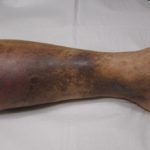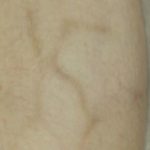Hemosiderin staining is a byproduct of the breakdown of hemoglobin and iron leaking out from veins in the legs. Hemoglobin is found in red blood cells and serves to transport oxygen from the lungs to the rest of the body. The released iron is then converted into hemosiderin and is stored in tissues under the skin. The stored hemosiderin can lead to brown, discoloration of the skin, a condition known as hemosiderin staining.
Causes of Hemosiderin Staining
Several factors can cause the development of hemosiderin stains. There are two of the common causes namely chronic venous insufficiency and sclerotherapy.


Chronic venous insufficiency
Chronic venous insufficiency is a condition that develops when veins in the lower legs are not able to return blood to the heart. This insufficient return thereby leads to pooling of blood in the lower legs. Over time, the red blood cells break down, releasing hemoglobin which is then converted to hemosiderin and stored in lower leg tissues. Causes of venous insufficiency are:
- Varicose veins: These can develop as a result of weak or incompetent valves in veins in the lower legs. These veins thereby become dilated and enlarged. As such, they are unable to prevent the backflow of blood thus leading to blood pooling in the lower legs.
- Physical inactivity: Blood can pool in the lower legs as a result of sitting or standing for long periods of time without moving.
Sclerotherapy
Sclerotherapy is one of the treatment modalities for varicose and spider veins. It involves the injection of a substance known as a sclerosant into the veins. This leads to the scarring and reduction of the veins. In some people, this treatment may leave them with a brown skin discoloration as a result of hemosiderin deposits. This discoloration is usually transient and disappears in a couple of weeks; however, in some people, the stain ends up being permanent.
In addition to those discussed above, other uncommon causes of hemosiderin staining are trauma, surgery, diabetes, and lipodermatosclerosis which is a disease of the skin.
Hemosiderin Staining Cream and Natural Remedy
Creams and gels: Creams and gels applied topically can help lighten hemosiderin stains and improve their cosmetic appearance. The stains from sclerotherapy can be treated with Arnica Gel. Arnica gel is a homeopathic gel that is known to reduce bruising and staining from vein treatment.
2% Hydroquinone: An effective dark sport remover for staining after sclerotherapy injections. Also effective for hemosiderin staining after vein treatment.
Laser treatment: Lasers can be used to remove hemosiderin stains. Similar to topical creams, they may not remove the stains completely but reduce their visibility.
Ultimately, the best way to manage hemosiderin staining is to address the underlying causes. Avoiding long periods of immobility is essential. Furthermore, a vein doctor should be seen if there is a suspicion of varicose veins.
Medically reviewed by Dr. Susanne Woloson on 5-01-2020.
*Disclaimer: “We are a participant in the Amazon Services LLC Associates Program, an affiliate advertising program designed to provide a means for us to earn fees by linking to Amazon.com and affiliated sites.”
Read This Next
Hemosiderin staining is a byproduct of the breakdown of hemoglobin and iron leaking out from veins in the legs. Hemoglobin is found in red blood cells and serves to transport...
Read MoreVenous reflux disease, or chronic venous insufficiency, is a chronic vein condition of the legs that can cause swelling, cramps, and pain. With proper treatment, however,...
Read MoreIf you notice that you have brown spots on your lower legs, feet or ankles, you may want to schedule an appointment with a vein specialist. Brown discolorations or spots...
Read More




